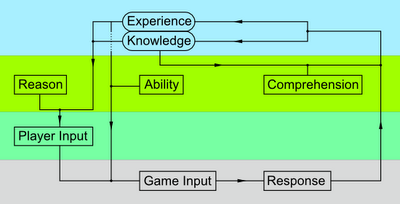
Player Accumulated Wisdom
A player, when approaching a Situation, brings with him/her the following accumulated attributes:
Knwoledge: This represents the accumulated information that the player has about the game up until this point. This represents, among other things, the player's understanding of the current Situation, the player's understanding of what Input the player may provide to the game, and the player's knowledge of what happened previously. Knowledge may be obtained through the application of Comprehension (and previous Knowledge) to the Result of a prior Situation. It may also be obtained from extra-game sources (online FAQ, hints from a friend, etc).
Experience: This represents the accumulated ability of the player to manipulate the game's user interface. Experience may be acquired through the application of Comprehension and Knowledge to the Result of a prior Situation. Experience may be acquired through other extra-game sources (playing a similar game with a similar user interface, etc).
Fundamental Player Attributes
The player, in addition to accumulated wisdom, brings with him/her certain fundamental attributes of that player. These attributes do not change from Situation to Situation; they represent basic constructs of the particular person playing the game. As part of the Situation Model, these attributes fully define a specific person playing the game. They also do not change over time.
Reason: This attribute is used to process Knowledge and Experience to produce the Player Input that the player wishes to use in a particular Situation.
Ability: This attribute represents the player's skills at manual dexterity. This attribute is used, when coupled with the player's accumulated Experience, to transform Player Input into Game Input.
Comprehension: This attribute represents the player's skill at understanding what he/she is being presented with. It is used to generate new Knowledge and Experience, but previous Knowledge informs this process as well.
Player's Mind
These constructs take place entirely within the player's mind.
Player Input: This is the specific sequence of commands that the player would like to tell the game in order to meet the Situation and achieve a Result. Player Input is generated by applying the player's Reason to the player's body of Knowledge and Experience. Player Input is then entered into the game by applying the player's Ability to the player's body of Experience.
The Game
Game Input: This is the valid input that the game receives from the player. The player uses his/her Ability, informed by Experience, and the player's Player Input to generate this information. The game outputs a Result based on this input and the specifics of its game design.
Result: This is the output from the game's processing of the Game Input. It is based on the Game Input and the game's design. It can be transformed into the player's Knowledge and Experience when the player's Comprehension is applied to the Result, informed by the player's current Knowledge.
Mapping Table: For a specific situation, the Mapping Table is the set of all possible mappings from Game Input to Results in this Situation. These mappings may not be 1:1, and there can be random or chaotic elements in the Design, such that it makes it difficult for the player to predict whether a particular Game Input will produce a particular Result.
No comments:
Post a Comment